A Capacity Expansion Model of Hydrogen Energy Storage for Urban-Scale Power Systems: A Case Study in Shanghai
Abstract
1. Introduction
2. Framework of Electricity–Hydrogen Collaborative Power System
2.1. Urban Power Architecture Under High Proportion of Renewable Energy
2.2. Urban Traditional Energy Generation System
2.3. Urban Renewable Energy Generation System
2.4. Electric Hydrogen Energy Conversion System
2.5. Urban Energy Storage Systems Involving Long-Term Hydrogen Storage
3. Model, Method, and Materials
3.1. Objective Function of Urban Power System Operation
3.2. Urban Power System Constraint
3.3. Levelized Cost of Urban Comprehensive Energy
3.4. Shanghai’s Urban Wind–Solar Resource Condition
3.5. Shanghai Urban Power System Planning Scenarios
4. Results and Analysis
4.1. The Results of Shanghai Urban Power Planning
- (1)
- Early stage of industrial development (2030–2040): Due to the high cost of hydrogen energy storage, the deployment scale of electrolytic cells and hydrogen power generation is relatively small. By 2035, they will account for 8% of the installed power supply and 10% of the annual average electricity load.
- (2)
- Large-scale development period (2040–2050): With the further reduction in hydrogen storage costs and the increase in renewable energy installed capacity, by 2050, electrolytic cells and hydrogen power generation installed capacity will account for 24% and 22%, respectively.
- (3)
- High-quality development period (2050–2060): The scale of long-term hydrogen storage deployment will have slowed down. By 2060, the installed capacity of electrolytic cells could reach 27.1 GW, the installed capacity of hydrogen power generation equipment could reach 21.9 GW, and the deployed hydrogen storage system scale will be 72 kt.
4.2. The Operation Results of Long-Term Hydrogen Energy Storage
4.3. Economic Analysis of Shanghai’s Urban Power Supply with the Participation of Long-Term Hydrogen Energy Storage
5. Discussions
5.1. Discussion on the Installed Capacity of Hydrogen Energy Storage Under Uncertainty of Power Demand
- (1)
- General Forecast Scenario (GFS): This rises smoothly from 200 TWh (2025) to 330 TWh (2060), which is applied to the planning scenario in Section 4.
- (2)
- High Growth Scenario (HGS): This reflects rapid electrification, reaching 231.25 TWh by 2030 and 362.5 TWh by 2060. The annual growth is 15% higher than the GFS scenario.
- (3)
- Low Growth Scenario (LGS): This assumes aggressive efficiency gains and industrial relocation, peaking at only 218.75 TWh in 2030 and 297.5 TWh in 2060. The annual growth is 15% lower than the GFS scenario.
5.2. Discussion on Cost Sensitivity of Hydrogen Energy Equipment
6. Conclusions
Author Contributions
Funding
Data Availability Statement
Conflicts of Interest
Appendix A. Relevant Parameters, Such as Cost Data Used in Supplementary Measurements
| Shanghai’s Power Installation Planning of BAS(GW) | 2024 | 2030 | 2035 | 2040 | 2045 | 2050 | 2055 | 2060 |
|---|---|---|---|---|---|---|---|---|
| Coal | 14.4 | 17.6 | 17.6 | 17.6 | 17.6 | 17.6 | 17.6 | 17.6 |
| Gas | 8.9 | 10.1 | 10.1 | 10.1 | 10.1 | 10.1 | 10.1 | 10.1 |
| Electrochemical energy storage | 1.0 | 2.0 | 2.5 | 3.0 | 4.0 | 5.5 | 7.0 | 9.0 |
| Onshore wind power | 0.4 | 1.2 | 1.8 | 2.8 | 3.5 | 43. | 5.0 | 6.0 |
| Offshore wind power | 0.8 | 8.8 | 11.2 | 15.2 | 22.0 | 29.0 | 30.0 | 30.0 |
| PV | 3.7 | 100 | 13.0 | 15.0 | 17.7 | 20.2 | 22.0 | 25.0 |
| Other REs | 2.1 | 2.1 | 2.1 | 2.1 | 2.1 | 2.1 | 2.1 | 2.1 |
| Proportion of RE capacity (%) | 22.2 | 42.7 | 48.2 | 53.4 | 58.8 | 62.6 | 63.0 | 63.2 |
| Device Type (¥/kw) | 2025 | 2030 | 2035 | 2040 | 2045 | 2050 | 2055 | 2060 |
|---|---|---|---|---|---|---|---|---|
| Coal | 4200 | 4500 | 4800 | 5000 | 5200 | 5500 | 5800 | 6000 |
| Gas | 3800 | 3900 | 4000 | 4200 | 4400 | 4600 | 4800 | 5000 |
| Other REs | 12,000 | 11,500 | 11,000 | 10,500 | 10,000 | 9500 | 9000 | 8500 |
| Onshore wind power | 5500 | 4800 | 4200 | 3800 | 3500 | 3200 | 3000 | 2800 |
| Offshore wind power | 6800 | 6600 | 6000 | 5300 | 4600 | 4000 | 3400 | 3200 |
| PV | 3200 | 2600 | 2200 | 1900 | 1700 | 1500 | 1400 | 1300 |
| Electrolyzer | 2000 | 1600 | 1300 | 1000 | 850 | 700 | 600 | 500 |
| Hydrogen storage tank | 1200 | 1000 | 800 | 650 | 500 | 400 | 350 | 300 |
| Hydrogen-fired power generation | 8000 | 6000 | 4500 | 3500 | 2800 | 2200 | 1800 | 1500 |
| Variable Parameters | 2025 | 2030 | 2035 | 2040 | 2045 | 2050 | 2055 | 2060 |
|---|---|---|---|---|---|---|---|---|
| Hydrogen production efficiency, | - | 0.65 | 0.70 | 0.75 | 0.78 | 0.81 | 0.83 | 0.85 |
| Hydrogen power generation efficiency, | - | 0.33 | 0.35 | 0.4 | 0.5 | 0.55 | 0.6 | 0.65 |
| Lower limit of coal power output, | 0.4 | 0.38 | 0.36 | 0.32 | 0.3 | 0.28 | 0.26 | 0.25 |
| Lower limit of gas power output, | 0.3 | 0.28 | 0.26 | 0.22 | 0.2 | 0.18 | 0.16 | 0.15 |
| Unit cost of coal power, | 0.3 | 0.4 | 0.45 | 0.5 | 0.55 | 0.6 | 0.65 | 0.7 |
| Unit cost of gas power, | 0.35 | 0.45 | 0.5 | 0.6 | 0.75 | 0.8 | 0.85 | 0.9 |
| Unit cost of onshore wind power, | 0.15 | 0.12 | 0.1 | 0.09 | 0.08 | 0.07 | 0.06 | 0.05 |
| Unit cost of offshore wind power, | 0.25 | 0.2 | 0.18 | 0.16 | 0.14 | 0.11 | 0.08 | 0.06 |
| Photovoltaic unit cost, | 0.1 | 0.08 | 0.07 | 0.06 | 0.05 | 0.05 | 0.04 | 0.03 |
| Unit cost of other power, | 0.3 | 0.4 | 0.45 | 0.5 | 0.55 | 0.6 | 0.65 | 0.7 |
| Invariant parameters | ||||||||
| (m/s) | 13 | (m/s) | 3 | (m/s) | 21 | |||
| Charge discharge constraint, | 0.25 | Charge discharge efficiency | 0.95 | Hydrogen storage/release coefficient | 0.025 | |||
| Hydrogen storage/release efficiency, | 0.98 | Hydrogen production ramp | 0.5 | Hydrogen production downward | 1 | |||
| Coal generation ramp, | 0.25 | Coal generation downward | 0.125 | Gas generation downward | 0.6 | |||
| Gas generation ramp, | 0.3 | |||||||
| Shanghai’s Power Installation Planning of HES(GW) | 2024 | 2030 | 2035 | 2040 | 2045 | 2050 | 2055 | 2060 |
|---|---|---|---|---|---|---|---|---|
| Coal | 14.4 | 16.2 | 16.3 | 15.7 | 13.2 | 11.1 | 10.5 | 10.4 |
| Gas | 8.9 | 9.5 | 10.0 | 9.0 | 8.0 | 7.6 | 7.6 | 7.5 |
| Electrochemical energy storage | 0.0 | 0.7 | 1.0 | 2.8 | 4.3 | 5.0 | 7.4 | 7.3 |
| Onshore wind power | 0.4 | 1.8 | 3.0 | 3.8 | 4.4 | 4.8 | 5.2 | 5.2 |
| Offshore wind power | 0.8 | 8.8 | 12.5 | 15.2 | 24.5 | 29.6 | 31.5 | 34.8 |
| PV | 3.7 | 4.9 | 10.3 | 14.5 | 19.4 | 22.4 | 27.3 | 33.2 |
| Other REs | 2.1 | 2.1 | 2.1 | 2.1 | 2.1 | 2.1 | 2.1 | 2.1 |
| Proportion of RE capacity (%) | 22.3 | 46.3 | 55.6 | 62.5 | 65.9 | 67.9 | 70.4 | 75.4 |
| Electrolyzer | - | 3.8 | 6.3 | 5.9 | 15.4 | 17.5 | 18.2 | 27.1 |
| Hydrogen power generator | - | 5.2 | 5.5 | 12.4 | 15.5 | 16.3 | 17.4 | 21.9 |
| Hydrogen storage tank (kt) | - | 0.47 | 0.83 | 1.86 | 3.2 | 2.7 | 7.9 | 7.2 |
References
- Cowell, R. Wind power, landscape and strategic, spatial planning—The construction of ‘acceptable locations’ in Wales. Land Use Policy 2010, 27, 222–232. [Google Scholar] [CrossRef]
- Yi, B.W.; Xu, J.H.; Fan, Y. Inter-regional power grid planning up to 2030 in China considering renewable energy development and regional pollutant control: A multi-region bottom-up optimization model. Appl. Energy 2016, 184, 641–658. [Google Scholar] [CrossRef]
- Sager, F. Planning, power, and policy change in the networked city: The politics of a new tramway in the city of Bern. In The Social Fabric of the Networked City; Polish Review; EPFL Press: Lausanne, Switzerland; Routledge: Abingdon-on-Thames, UK, 2008. [Google Scholar]
- Kam Ng, M. From a Special Economic Zone to a Smart Sustainable City: The Power of Strategic Spatial Planning in Shenzhen. Built Environ. 2022, 48, 581–593. [Google Scholar] [CrossRef]
- Wang, C.; Liu, C.; Chen, J.; Zhang, G. Cooperative planning of renewable energy generation and multi-timescale flexible resources in active distribution networks. Appl. Energy 2024, 356, 122429. [Google Scholar] [CrossRef]
- Chu, C.-C.; Wu, Y.-K.; Lian, K.-L.; Liu, J.-H. Guest Editorial Towards Resilient Power Grids Integrated With High-Penetrated Renewable Energy Sources: Challenges, Opportunities, Implementation Strategies, and Future Perspectives. IEEE Trans. Ind. Appl. 2024, 60, 1960–1962. [Google Scholar] [CrossRef]
- Arboleya, P.; Méndez, A. Real-Time Grid Digital Twins: The backbone of the next generation of network technology for distribution system operators. IEEE Electrif. Mag. 2024, 12, 39–49. [Google Scholar] [CrossRef]
- Mehta, Y.; Lo, V.; Mehta, V.; Agrawal, K.; Madabathula, C.T.; Chang, E.; Gao, J. Renewable Electricity Management Cloud System for Smart Communities Using Advanced Machine Learning. Energies 2025, 18, 1418. [Google Scholar] [CrossRef]
- Zhang, H.; Liao, K.; Yang, J.; Zheng, S.; He, Z. Frequency-constrained expansion planning for wind and photovoltaic power in wind-photovoltaic-hydro-thermal multi-power system. Appl. Energy 2024, 356, 122401. [Google Scholar] [CrossRef]
- Zhao, Z.; Yang, K. Suitability matching evaluation of the low-carbon regional integrated energy system based on the ‘resource-demand’ balance. Sustain. Energy Technol. Assess. 2024, 72, 104099. [Google Scholar] [CrossRef]
- Dong, Y.; Wang, C.; Zhang, H.; Zhou, X. A novel multi-objective optimization framework for optimal integrated energy system planning with demand response under multiple uncertainties. Inf. Sci. 2024, 663, 120252. [Google Scholar] [CrossRef]
- Liu, Y.; Lv, M.; Sun, K. Comprehensive tradeoff and utilization of airborne renewable energy and uncertain stratospheric wind potential based on reinforcement learning. Energy 2025, 324, 135932. [Google Scholar] [CrossRef]
- Memarzadeh, G.; Keynia, F.; Amirteimoury, F.; Memarzadeh, R.; Noori, H. A New Hybrid Intelligent Method for Accurate Short Term Electric Power Production Forecasting from Uncertain Renewable Energy Resources. Int. J. Ind. Electron. Control Optim. 2025, 8, 45–55. [Google Scholar]
- Fakhry, A.E.; Gomaa, M.; Metwaly, A.A.; Abdelhafeez, A. Machine Learning Models with Neutrosophic Numbers for Cloud Security Analysis and Smart Grid Control of Renewable Energy. Neutrosophic Sets Syst. 2025, 85, 960–973. [Google Scholar]
- Liu, M.; Zhu, J.; Liu, M. Optimal AC Power Flow with Energy Storage and Renewable Energy: An Efficient RL Algorithm Capable of Handling Equality Constraints. Int. J. Comput. Intell. Syst. 2025, 18, 27. [Google Scholar] [CrossRef]
- Zhou, Z. Self-Sustainability for green energy in megacities: A case Study of Shanghai towards Net-Zero Goal. E3S Web Conf. 2024, 527, 03016. [Google Scholar] [CrossRef]
- Shanghai Municipal Commission of Economy and Information Technology. Key Performance Indicators Report on Environmental Sustainability of Shanghai Power Supply (2024). 2024, Shanghai. Available online: https://www.sheitc.sh.gov.cn/cmsres/b0/b09cd80f5b1c4a45828ebb85e70c9ace/5bf5394163353f25d4db20ff92ba286f.pdf (accessed on 7 September 2025).
- Schoenung, S.M.; Hassenzahl, W. Characteristics and Technologies for Long- vs. Short-Term Energy Storage: A Study by the DOE Energy Storage Systems Program; United States Department of Energy: Livermore, CA, USA, 2001. [Google Scholar]
- Albertus, P.; Manser, J.S.; Litzelman, S. Long-term Electricity Storage Applications, Economics, and Technologies. Joule 2020, 4, 21–32. [Google Scholar] [CrossRef]
- Sander, M.; Gehring, R. LIQHYSMES—A Novel Energy Storage Concept for Variable Renewable Energy Sources Using Hydrogen and SMES. IEEE Trans. Appl. Supercond. A Publ. IEEE Supercond. Comm. 2011, 21, 1362–1366. [Google Scholar] [CrossRef]
- Dabade, D.; Dudhe, V.; Dambhare, S. A review on modelling of stator of pumped storage synchronous generator for protection schemes against stator earth fault. AIP Conf. Proc. 2024, 3188, 060009. [Google Scholar]
- Ye, L.; Qi, S.; Cheng, T.; Jiang, Y.; Feng, Z.; Wang, M.; Liu, Y.; Dai, L.; Wang, L.; He, Z. Vanadium Redox Flow Battery: Review and Perspective of 3D Electrodes. ACS Nano 2024, 18, 18852–18869. [Google Scholar] [CrossRef]
- Wang, K.; Chen, L.; Li, X.; Zhu, C. Research on compressed air energy storage systems using cascade phase-change technology for matching fluctuating wind power generation. Front. Energy Res. 2024, 12, 1352540. [Google Scholar] [CrossRef]
- Hamburg Green Hydrogen Hub (HGHH) Consortium. Green Hydrogen Hub Europe—Hamburg; Hamburg Ministry of Economy: Hamburg, Germany, 2021. [Google Scholar]
- Port of Rotterdam Authority. Hydrogen Vision for the Port of Rotterdam. Rotterdam, May 2020. Available online: https://www.portofrotterdam.com/sites/default/files/2021-06/hydrogen-vision-port-of-rotterdam-authority-may-2020.pdf (accessed on 7 September 2025).
- Australian Renewable Energy Agency (ARENA). Hydrogen Park Murray Valley (HyP Murray Valley) Project. ARENA Project Factsheet, 2023. Available online: https://arena.gov.au/projects/hydrogen-park-murray-valley/ (accessed on 7 September 2025).
- Laghlimi, C.; Moutcine, A.; Ziat, Y.; Belkhanchi, H.; Koufi, A.; Bouyassan, S. Hydrogen, Chronology and Electrochemical Production. Sol. Energy Sustain. Dev. J. 2024, 14, 22–37. [Google Scholar] [CrossRef]
- Bounitsis, G.L.; Charitopoulos, V.M. Power system planning integrating hydrogen and ammonia pathways under uncertainty. Comput. Aided Chem. Eng. 2024, 53, 2191–2196. [Google Scholar]
- Wang, H.; Qin, B.; Ding, T.L.F. Optimal configuration of hybrid hydrogen-to-power system for power systems with high wind energy penetration. IET Gener. Transm. Distrib. 2024, 18, 2171–2183. [Google Scholar] [CrossRef]
- He, X.; Lu, T.; Li, J.; Sheng, W.; Li, R. Power System Capacity Planning Considering Seasonal Hydrogen Storage by Salt Caverns. arXiv 2023, arXiv:2311.12525. [Google Scholar] [CrossRef]
- Yi, Y.; Komiyama, R.; Fujii, Y. Development of Chinese Dynamic Optimal Power Expansion Planning Model Integrated with Hydrogen and Fuel Cell System. IEEJ Trans. Electr. Electron. Eng. 2023, 18, 834–848. [Google Scholar] [CrossRef]
- Nguyen, Q.M.; Nguyen, D.L.; Nguyen, Q.A.; Pham, T.N.; Phan, Q.T.; Tran, M.H. A Bi-level optimization for the planning of microgrid with the integration of hydrogen energy storage. Int. J. Hydrogen Energy 2024, 63, 967–974. [Google Scholar] [CrossRef]
- Zhang, W.; Han, Q.; Shang, W.L.; Xu, C. Seismic resilience assessment of interdependent urban transportation-electric power system under uncertainty. Transp. Res. Part A Policy Pract. 2024, 183, 19. [Google Scholar] [CrossRef]
- Maghami, M.R.; Pasupuleti, J.; Sundaram, S. Impact of time of use program on widely distribution generation interconnection in urban power network. J. Energy Storage 2024, 101 Pt A, 113789. [Google Scholar] [CrossRef]
- Kosmopoulos, P.; Dhake, H.; Kartoudi, D.; Tsavalos, A.; Koutsantoni, P.; Katranitsas, A.; Lavdakis, N.; Mengou, E.; Kashyap, Y. Ray-Tracing modeling for urban PV energy planning and management. Appl. Energy 2024, 369, 24. [Google Scholar] [CrossRef]
- Wang, C.; Lu, Z.; Zhang, J.; Guo, X.; Li, Y.; Zhang, J. Planning and economic analysis of low-carbon transition of East China power system considering electricity-hydrogen coupling. Renew. Energy 2025, 249, 123244. [Google Scholar] [CrossRef]
- Asghari, M.; Afshari, H.; Jaber, M.Y.; Searcy, C. Strategic analysis of hydrogen market dynamics across collaboration models. Renew. Sustain. Energy Rev. 2025, 208, 115001. [Google Scholar] [CrossRef]
- Cheng, A.; Xiao, W.; Ban, Y.; Shang, L.; Ruan, X.; Jiang, X.; He, G. Optimization and 4E analysis of a distributed methanol reforming trigeneration system of electricity, hydrogen, and heat enhancement by high temperature electrically driven hydrogen separation. Int. J. Hydrogen Energy 2025, 118, 373–393. [Google Scholar] [CrossRef]
- Rong, F.; Liang, W.; Yuan, X.; Wang, Q.; Ma, Q.; Zuo, J. Thermo-economic feasibility analysis of a novel integrated energy system based on solar hydrogen production. Energy 2025, 332, 137230. [Google Scholar] [CrossRef]
- Kennedy, K.M.; Borrero, M.A.; Edwards, M.R.; O’ROurke, P.; Hultman, N.E.; Surana, K. Advancing equitable value chains for the global hydrogen economy. Energy Clim. Change 2024, 5, 100166. [Google Scholar] [CrossRef]
- Xie, T.; Wang, Q.; Zhang, G.; Zhang, K.; Li, H. Low-Carbon Economic Dispatch of Virtual Power Plant Considering Hydrogen Energy Storage and Tiered Carbon Trading in Multiple Scenarios. Processes 2024, 12, 27. [Google Scholar] [CrossRef]
- Chen, X.; Yang, L.; Dong, W.; Yang, Q. Net-zero carbon emission oriented Bi-level optimal capacity planning of integrated energy system considering carbon capture and hydrogen facilities. Renew. Energy 2024, 237, 121624. [Google Scholar] [CrossRef]
- Nicoli, M.; Faria, V.A.D.; de Queiroz, A.R.; Savoldi, L. Modeling energy storage in long-term capacity expansion energy planning: An analysis of the Italian system. J. Energy Storage 2024, 101 Pt A, 113814. [Google Scholar] [CrossRef]
- Xia, Q.; Zou, Y.; Wang, Q. Optimal Capacity Planning of Green Electricity-Based Industrial Electricity-Hydrogen Multi-Energy System Considering Variable Unit Cost Sequence. Sustainability 2024, 16, 3684. [Google Scholar] [CrossRef]
- Gao, X.; Zhang, G.; Nie, Y.; Xi, X.; Feng, Y. The social network perspective on power system co-evolution: Responses to “double carbon target” realization in China. Environ. Sci. Pollut. Res. 2024, 31, 57114–57128. [Google Scholar] [CrossRef]
- Shanghai Municipal Government. Shanghai Carbon-Peaking Implementation Plan. 2022. Available online: https://www.ndrc.gov.cn/fggz/hjyzy/tdftzh/202208/t20220808_1332758_ext.html (accessed on 7 September 2025).
- Shanghai Municipal Government. Shanghai Municipal Carbon Emission Management Regulation. 2025. Available online: https://www.shanghai.gov.cn/xxzfgzwj/20250401/7dab726f8b55468c87eb920c49c0be89.html (accessed on 7 September 2025).
- Du, Y.; Yu, Y. Optimization Operation Strategy of Integrated Energy System Considering Load Flexibility and Energy Conversion Device. In Proceedings of the 2024 International Conference of Electrical, Electronic and Networked Energy Systems, Xi’an, China, 20–22 September 2024; Lecture Notes in Electrical Engineering. pp. 359–369. [Google Scholar]
- Xiao, Z.; Liu, Q.; Liang, Q.; Wu, D.; Ruan, Y.; Qian, F.; Xu, T.; Meng, H.; Yao, Y. Optimization of integrated energy systems with hydrogen storage: Incorporating experimentally validated partial load characteristics for enhanced renewable energy utilization. J. Phys. Conf. Ser. 2025, 3018, 012013. [Google Scholar] [CrossRef]
- IRENA. Green Hydrogen Cost Reduction: Scaling Up Electrolysers to Meet the 1.5 °C Climate Goal; International Renewable Energy Agency: Abu Dhabi, United Arab Emirates, 2020; ISBN 978-92-9260-295-6. [Google Scholar]
- IRENA. Making the Breakthrough: Green Hydrogen Policies and Technology Costs; International Renewable Energy Agency: Abu Dhabi, United Arab Emirates, 2021; ISBN 978-92-9260-314-4. [Google Scholar]
- Hydrogen Council. Global Hydrogen Flows; Hydrogen Council: Brussels, Belgium, 2021. [Google Scholar]

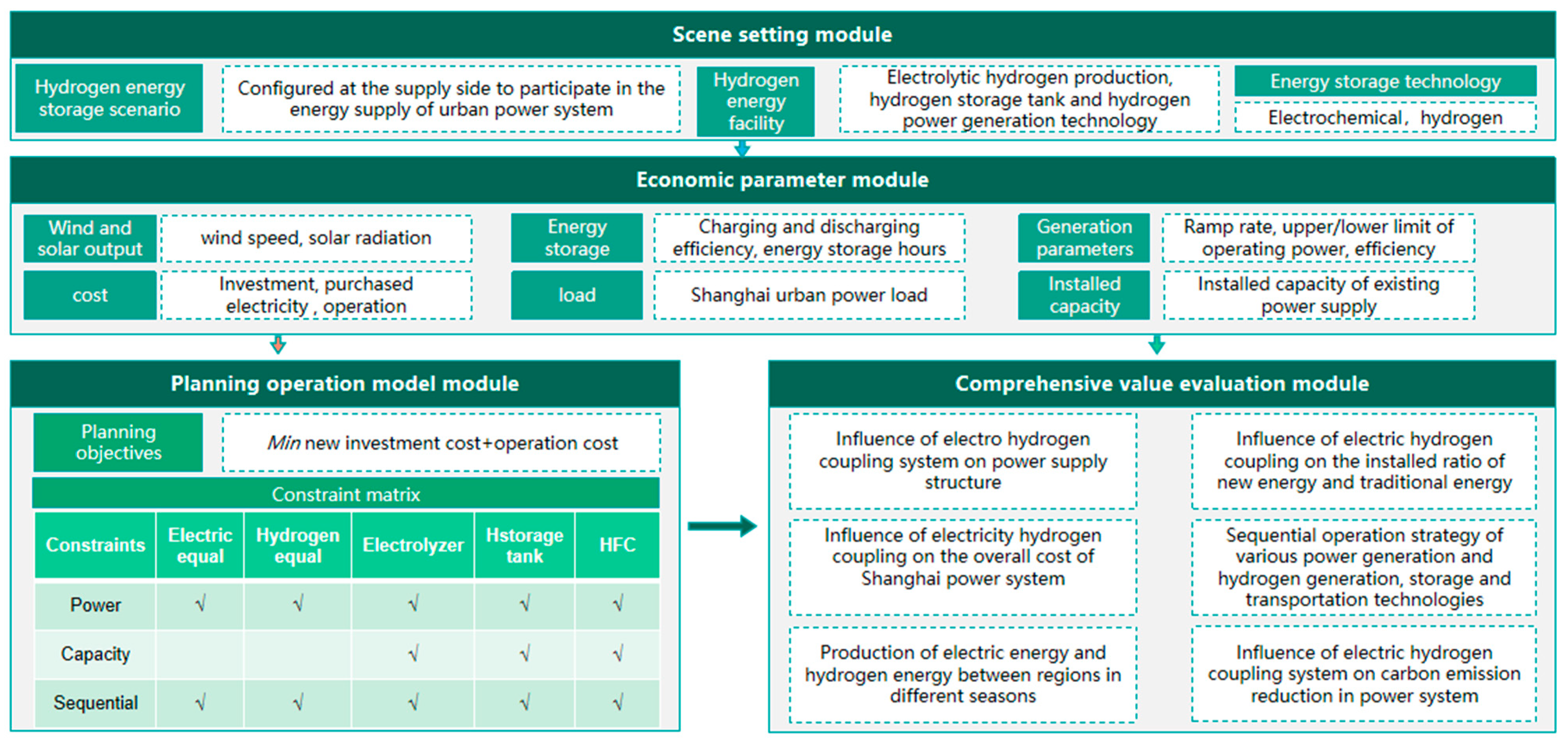

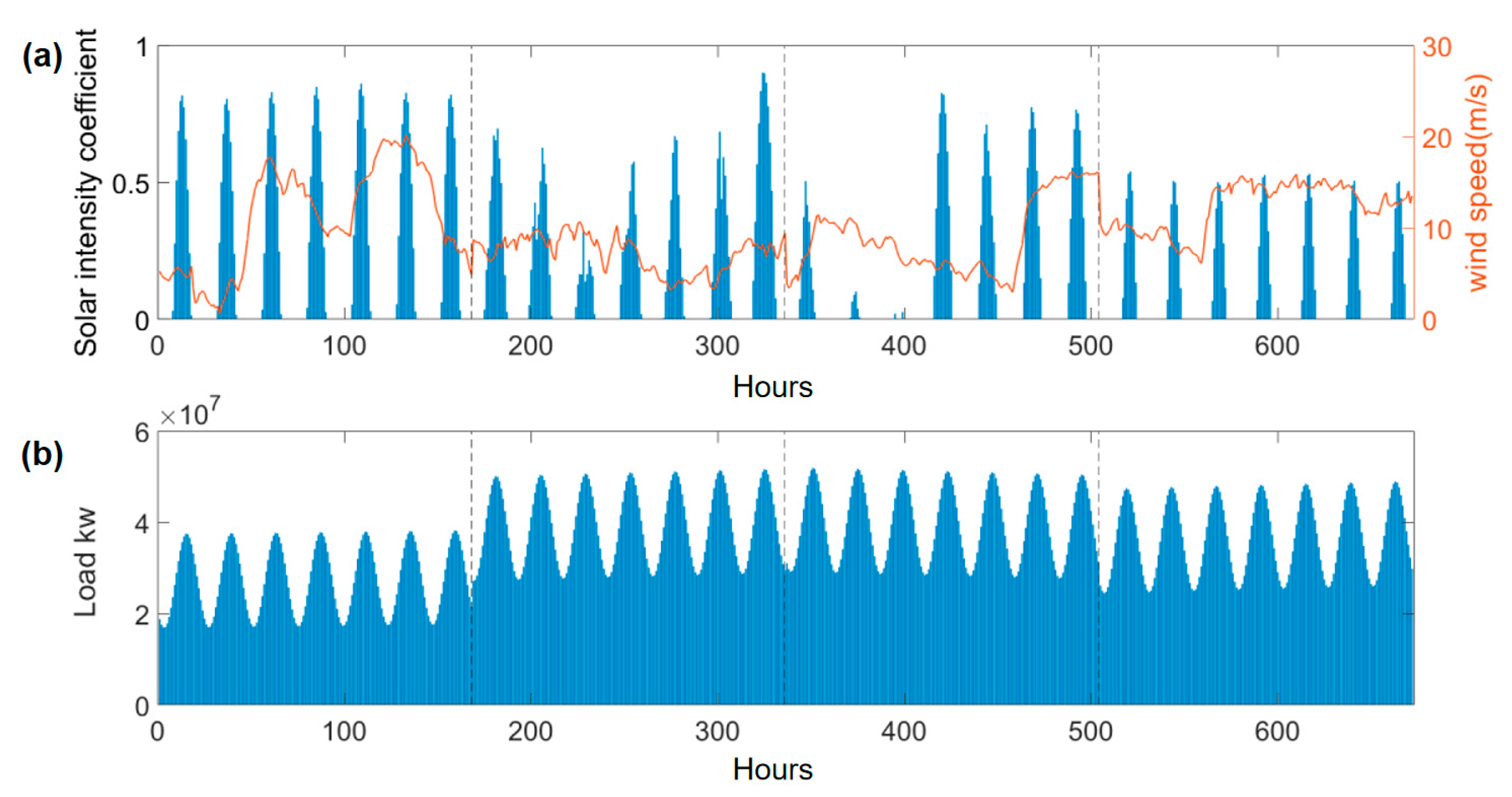
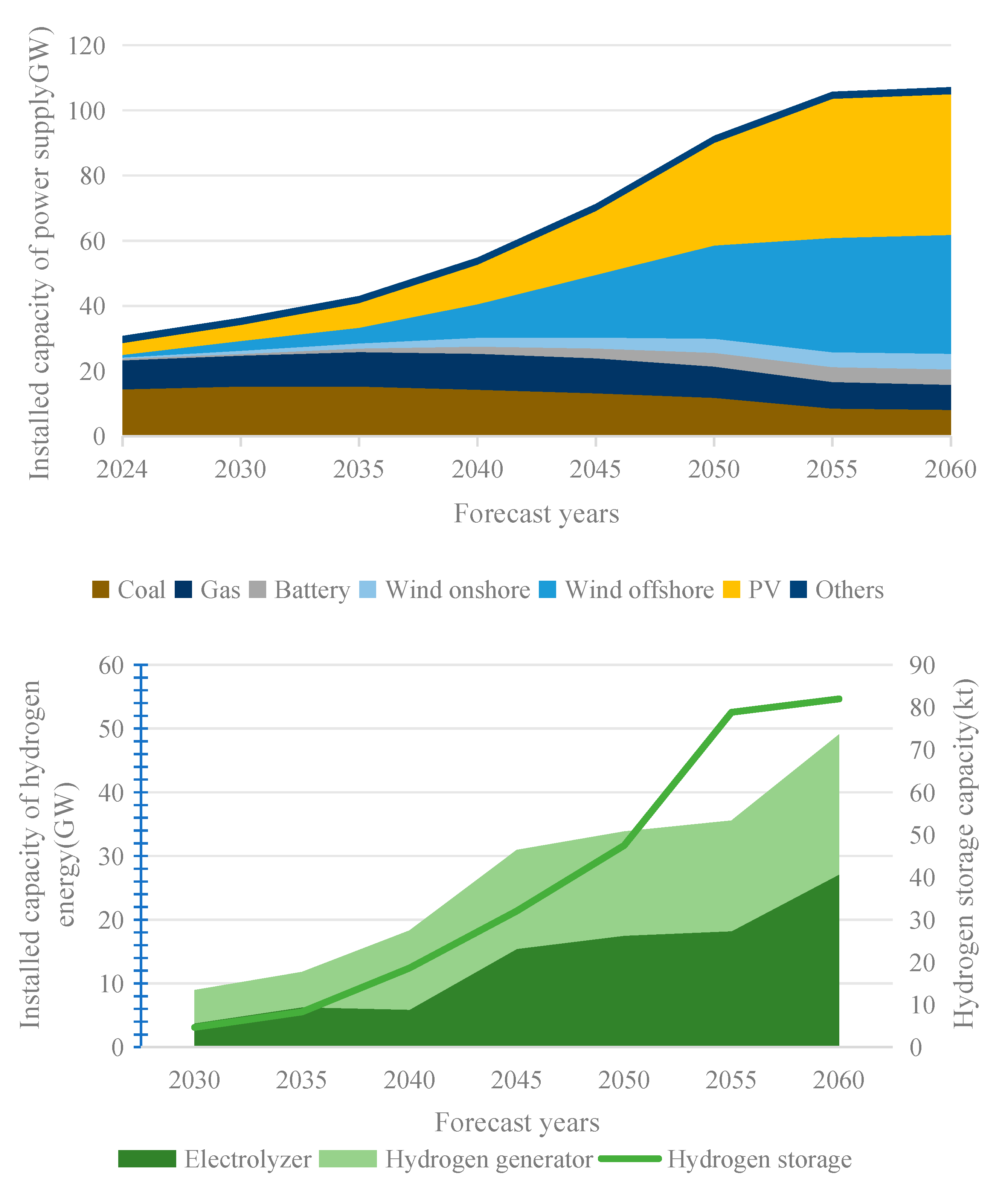
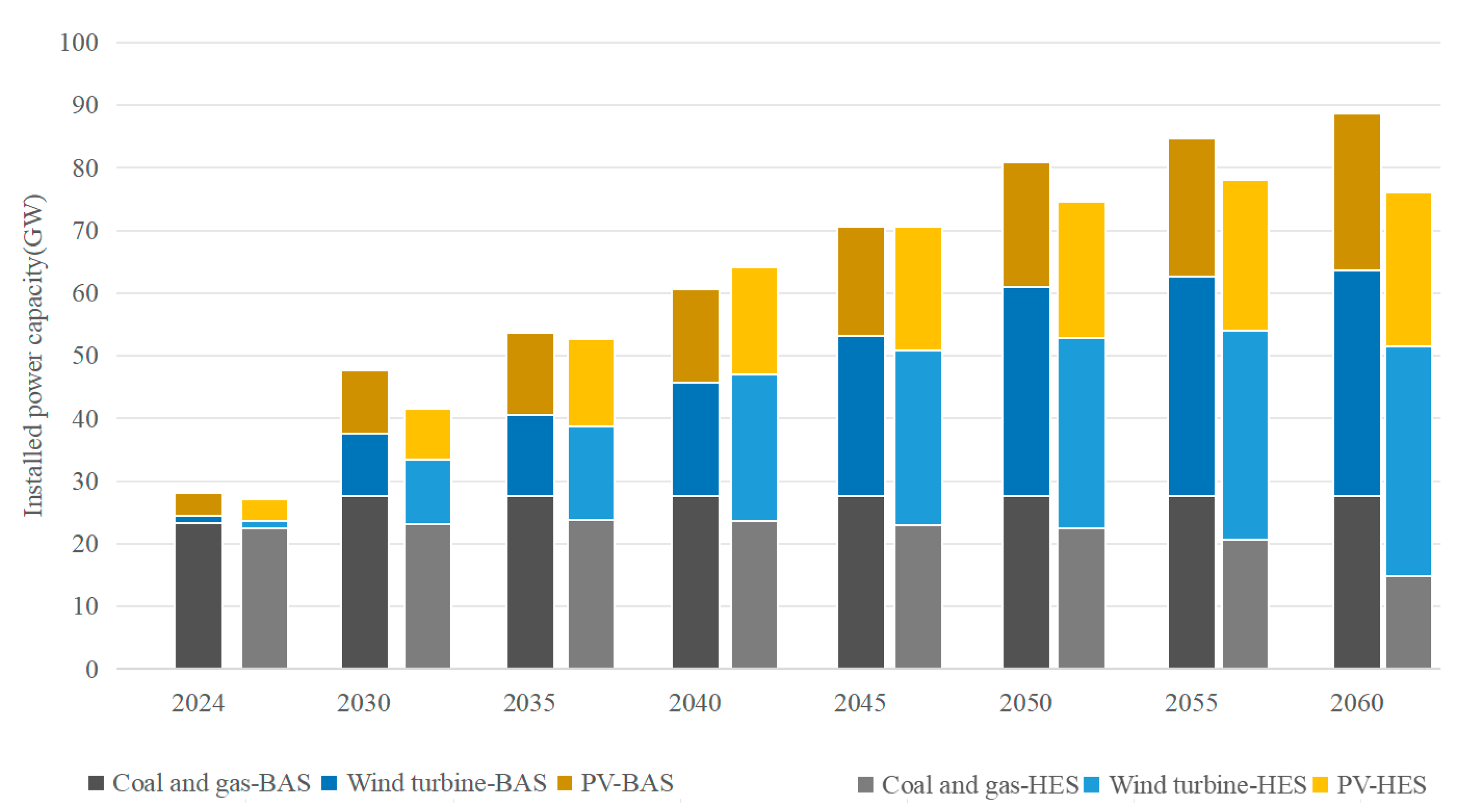
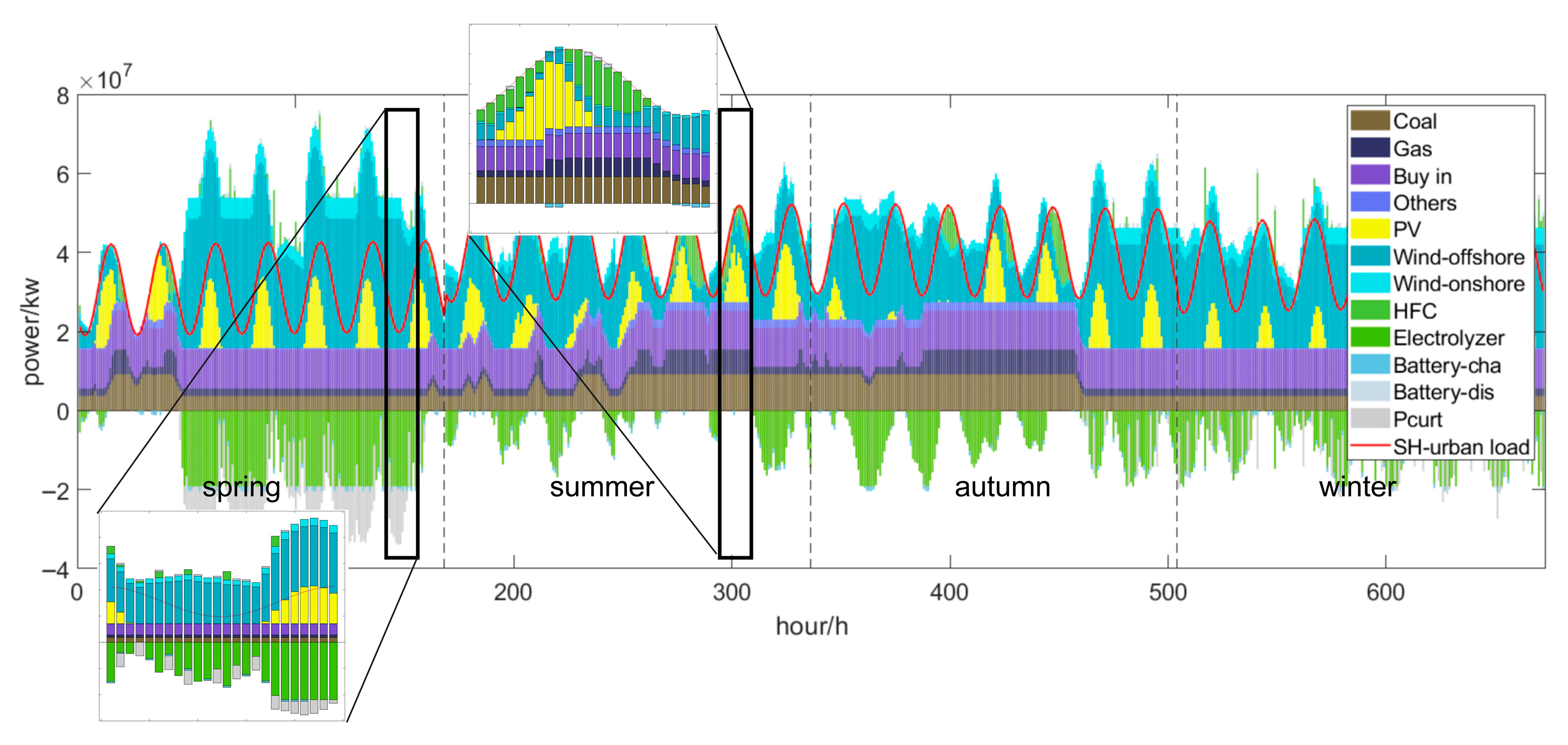
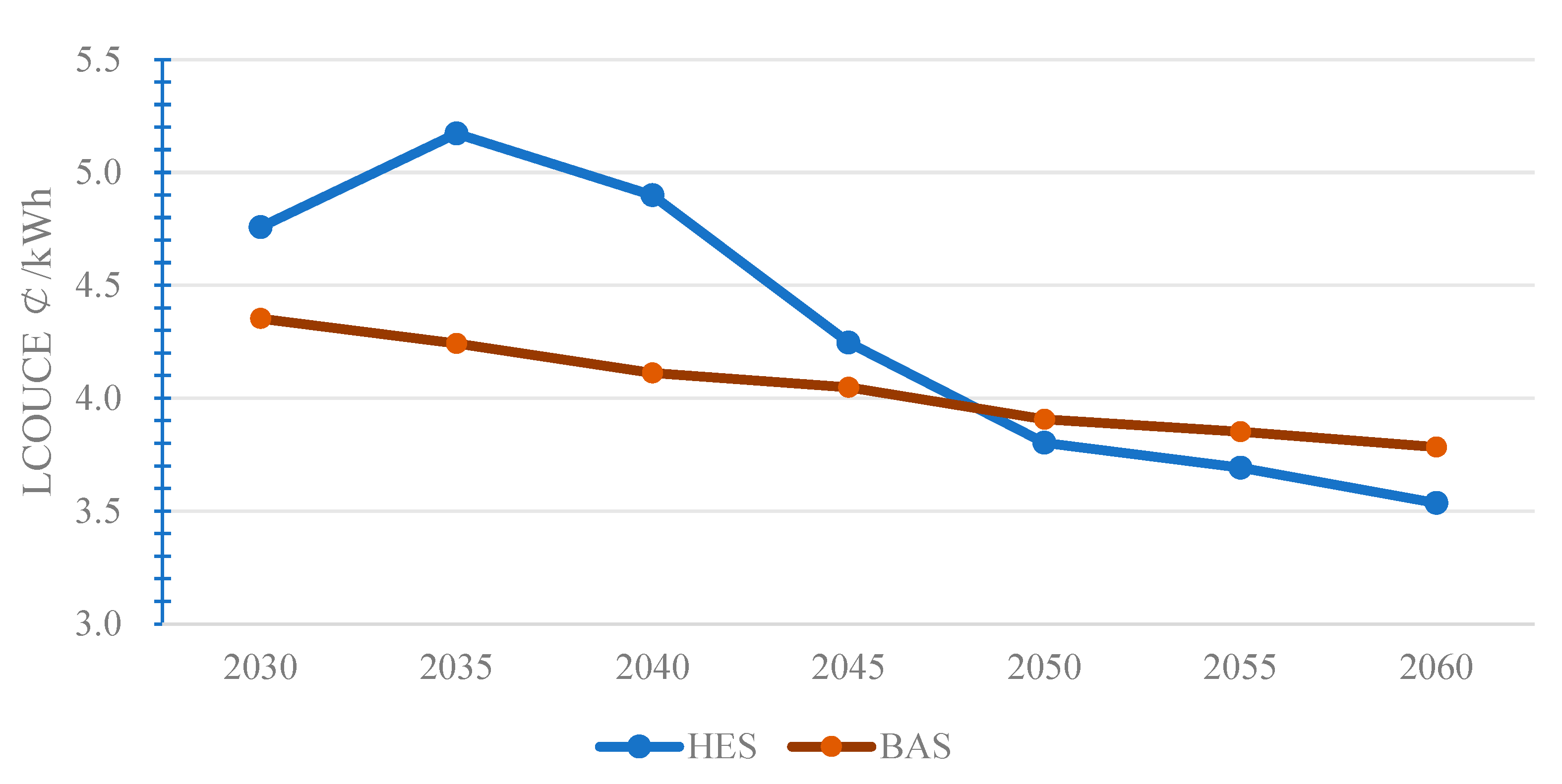

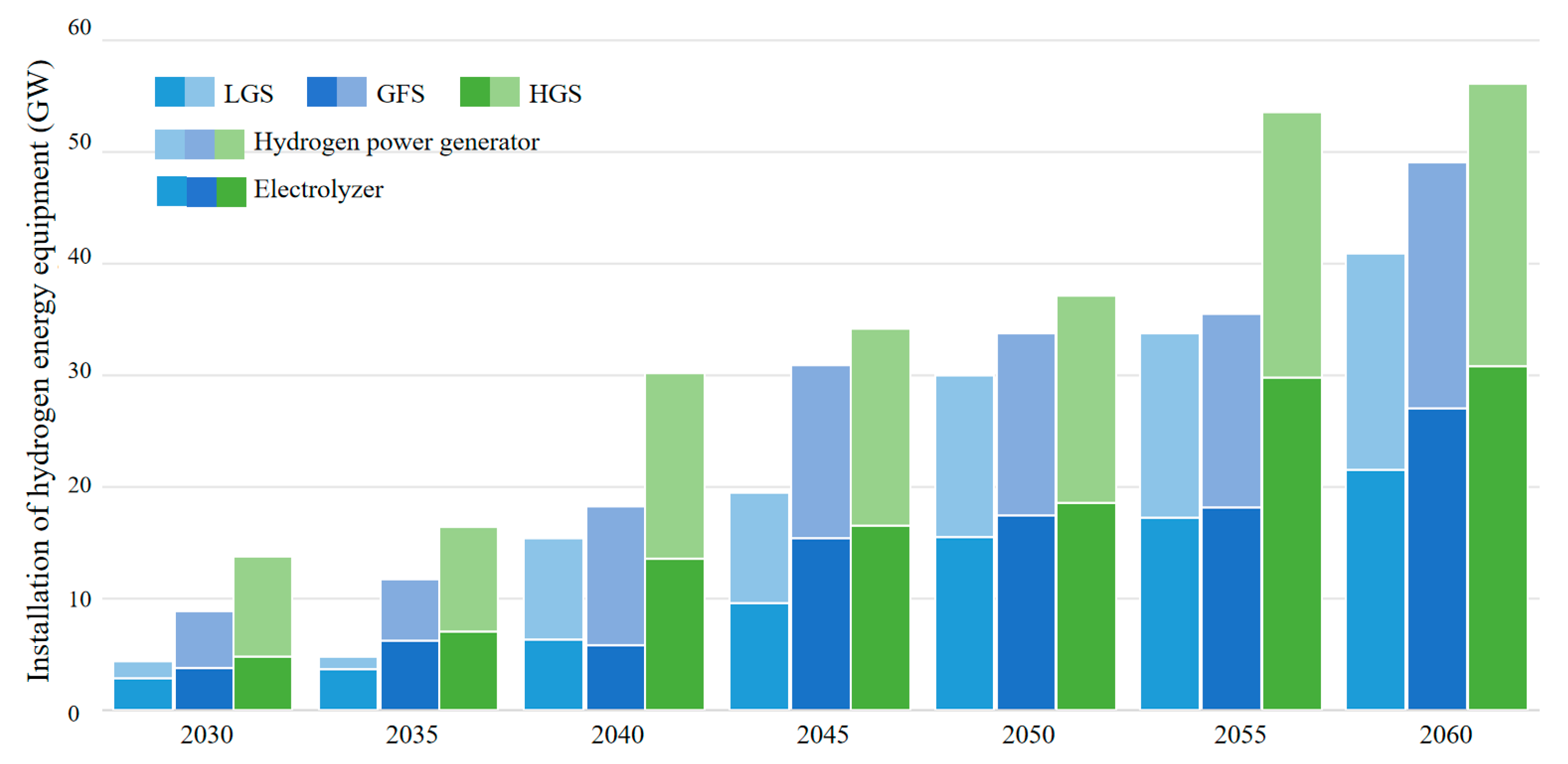
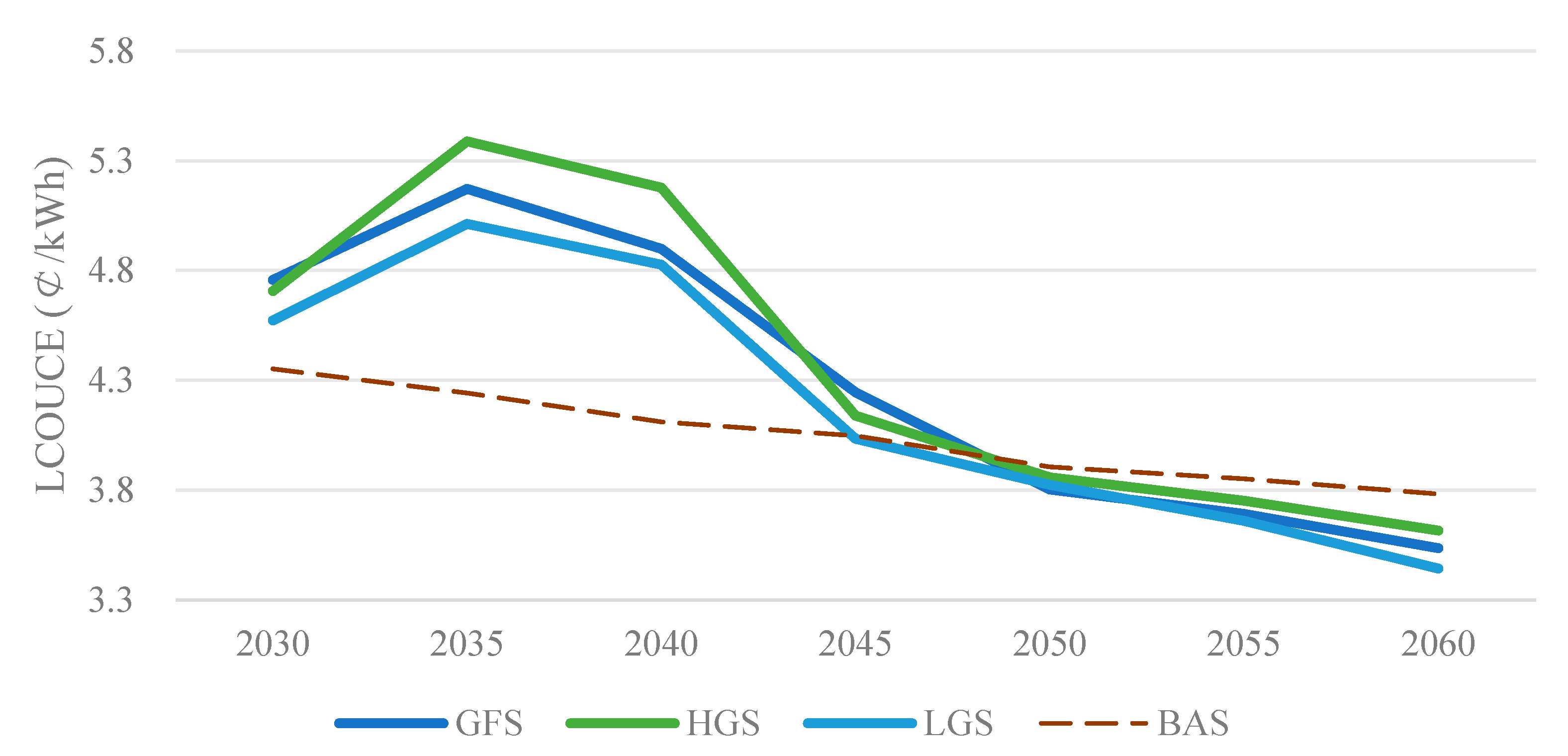

| Penetration Rates of RE% | 2030 | 2035 | 2040 | 2045 | 2050 | 2055 | 2060 |
|---|---|---|---|---|---|---|---|
| BAS | 28.8 | 34.9 | 37.5 | 42.4 | 48.5 | 52.3 | 52.4 |
| HES | 29.8 | 39.3 | 47.7 | 50.3 | 53.6 | 56.6 | 64.0 |
| Consumption Rates of RE% | 2030 | 2035 | 2040 | 2045 | 2050 | 2055 | 2060 |
|---|---|---|---|---|---|---|---|
| BAS | 92.4 | 89.5 | 88.7 | 86.4 | 82.6 | 82.3 | 82.0 |
| HES | 98.6 | 99.6 | 97.0 | 96.2 | 96.2 | 96.0 | 96.0 |
Disclaimer/Publisher’s Note: The statements, opinions and data contained in all publications are solely those of the individual author(s) and contributor(s) and not of MDPI and/or the editor(s). MDPI and/or the editor(s) disclaim responsibility for any injury to people or property resulting from any ideas, methods, instructions or products referred to in the content. |
© 2025 by the authors. Licensee MDPI, Basel, Switzerland. This article is an open access article distributed under the terms and conditions of the Creative Commons Attribution (CC BY) license (https://creativecommons.org/licenses/by/4.0/).
Share and Cite
Fu, C.; Suo, R.; Li, L.; Guo, M.; Liu, J.; Xu, C. A Capacity Expansion Model of Hydrogen Energy Storage for Urban-Scale Power Systems: A Case Study in Shanghai. Energies 2025, 18, 5183. https://doi.org/10.3390/en18195183
Fu C, Suo R, Li L, Guo M, Liu J, Xu C. A Capacity Expansion Model of Hydrogen Energy Storage for Urban-Scale Power Systems: A Case Study in Shanghai. Energies. 2025; 18(19):5183. https://doi.org/10.3390/en18195183
Chicago/Turabian StyleFu, Chen, Ruihong Suo, Lan Li, Mingxing Guo, Jiyuan Liu, and Chuanbo Xu. 2025. "A Capacity Expansion Model of Hydrogen Energy Storage for Urban-Scale Power Systems: A Case Study in Shanghai" Energies 18, no. 19: 5183. https://doi.org/10.3390/en18195183
APA StyleFu, C., Suo, R., Li, L., Guo, M., Liu, J., & Xu, C. (2025). A Capacity Expansion Model of Hydrogen Energy Storage for Urban-Scale Power Systems: A Case Study in Shanghai. Energies, 18(19), 5183. https://doi.org/10.3390/en18195183







